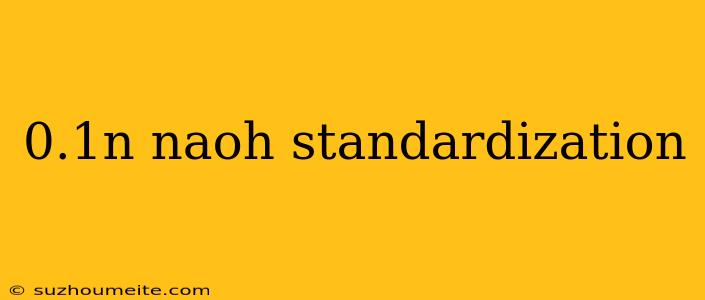0.1N NaOH Standardization
Introduction
Sodium hydroxide (NaOH) is a strong base commonly used in various laboratory applications, including titration reactions. To ensure accurate results, it is essential to standardize the NaOH solution against a primary standard acid. In this article, we will discuss the standardization of 0.1N NaOH solution using potassium hydrogen phthalate (KHP) as a primary standard acid.
Principle
The standardization of NaOH solution involves reacting it with a known amount of a strong acid, such as KHP, to produce a salt and water. The reaction is as follows:
NaOH (aq) + KHP (s) → NaKP (aq) + H2O (l)
By measuring the volume of NaOH solution required to neutralize a known amount of KHP, we can calculate the normality of the NaOH solution.
Materials
- 0.1N NaOH solution
- Potassium hydrogen phthalate (KHP)
- Distilled water
- Phenolphthalein indicator
- Burette or pipette
- Conical flask
Procedure
Preparation of KHP Solution
- Weighing: Weigh accurately about 2-3 grams of KHP into a conical flask.
- Dissolving: Add a small amount of distilled water to the flask and mix until the KHP is completely dissolved.
- Transferring: Transfer the KHP solution into a 100 mL volumetric flask.
- Diluting: Dilute the solution with distilled water up to the mark.
Standardization of NaOH Solution
- Pipetting: Pipette 25 mL of KHP solution into a conical flask.
- Adding Indicator: Add 2-3 drops of phenolphthalein indicator to the flask.
- Titration: Slowly add 0.1N NaOH solution from a burette or pipette into the flask while continuously stirring until the color of the solution changes from colorless to pink.
- Recording Volume: Record the volume of NaOH solution added.
- Repeating: Repeat steps 1-4 until three consecutive readings are consistent.
Calculation of Normality
- Molarity of KHP: The molarity of KHP is calculated using the weight of KHP used and the volume of the solution.
- Number of Milliequivalents: The number of milliequivalents of KHP is calculated by multiplying the molarity of KHP by the volume of the solution (in mL).
- Normality of NaOH: The normality of NaOH is calculated by dividing the number of milliequivalents of KHP by the volume of NaOH solution added (in mL).
Example Calculation
Suppose we obtain the following results:
- Weight of KHP: 2.453 g
- Volume of KHP solution: 100 mL
- Volume of NaOH solution added: 24.50 mL, 24.52 mL, and 24.55 mL
Molarity of KHP:
Molarity of KHP = (2.453 g / 204.22 g/mol) / 0.1 L = 0.12 M
Number of Milliequivalents:
Number of milliequivalents = 0.12 M x 25 mL = 3.00 milliequivalents
Normality of NaOH:
Normality of NaOH = 3.00 milliequivalents / 24.52 mL ≈ 0.122 N
Conclusion
The standardization of 0.1N NaOH solution using KHP as a primary standard acid is a simple and accurate method. By following the procedure outlined above, we can determine the normality of NaOH solution with high precision. This standardized NaOH solution can then be used in various titration reactions, such as acid-base titrations and redox titrations.
